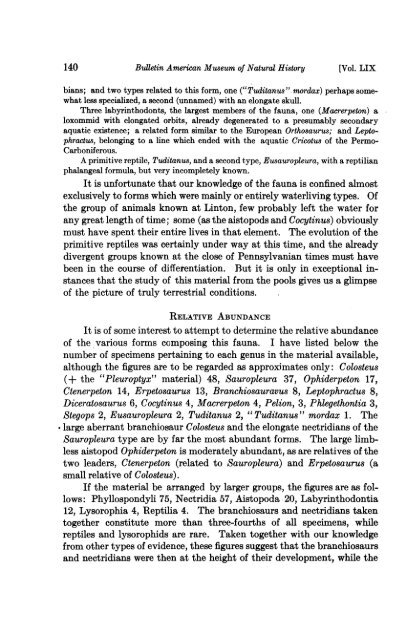View/Open - American Museum of Natural History
View/Open - American Museum of Natural History
View/Open - American Museum of Natural History
Create successful ePaper yourself
Turn your PDF publications into a flip-book with our unique Google optimized e-Paper software.
140 BuUlletin <strong>American</strong> <strong>Museum</strong> <strong>of</strong> <strong>Natural</strong> <strong>History</strong><br />
[Vol. LIX<br />
bians; and two types related to this form, one ("Tuditanus" mordax) perhaps somewhat<br />
less specialized, a second (unnamed) with an elongate skull.<br />
Three labyrinthodonts, the largest members <strong>of</strong> the fauna, one (Macrerpeton) a<br />
loxommid with elongated orbits, already degenerated to a presumably secondary<br />
aquatic existence; a related form similar to the European Orthosaurus; and Leptophractus,<br />
belonging to a line which ended with the aquatic Cricotus <strong>of</strong> the Permo-<br />
Carboniferous.<br />
A primitive reptile, Tuditanus, and a second type, Eusauropleura, with a reptilian<br />
phalangeal formula, but very incompletely known.<br />
It is unfortunate that our knowledge <strong>of</strong> the fauna is confined almost<br />
exclusively to forms which were mainly or entirely waterliving types. Of<br />
the group <strong>of</strong> animals known at Linton, few probably left the water for<br />
any great length <strong>of</strong> time; some (as the aistopods and Cocytinus) obviously<br />
must have spent their entire lives in that element. The evolution <strong>of</strong> the<br />
primitive reptiles was certainly under way at this time, and the already<br />
divergent groups known at the close <strong>of</strong> Pennsylvanian times must have<br />
been in the course <strong>of</strong> differentiation. But it is only in exceptional instances<br />
that the study <strong>of</strong> this material from the pools gives us a glimpse<br />
<strong>of</strong> the picture <strong>of</strong> truly terrestrial conditions.<br />
RELATIVE ABUNDANCE<br />
It is <strong>of</strong> some interest to attempt to determine the relative abundance<br />
<strong>of</strong> the various forms composing this fauna. I have listed below the<br />
number <strong>of</strong> specimens pertaining to each genus in the material available,<br />
although the figures are to be regarded as approximates only: Colosteus<br />
(+ the "Pleuroptyx" material) 48, Sauropleura 37, Ophiderpeton 17,<br />
Ctenerpeton 14, Erpetosaurus 13, Branchiosauravus 8, Leptophractus 8,<br />
Diceratosaurus 6, Cocytinus 4, Macrerpeton 4, Pelion, 3, Phlegethontia 3,<br />
Stegops 2, Eusauropleura 2, Tuditanus 2, "Tuditanus" mordax 1. The<br />
large aberrant branchiosaur Colosteus and the elongate nectridians <strong>of</strong> the<br />
Sauropleura type are by far the most abundant forms. The large limbless<br />
aistopod Ophiderpeton is moderately abundant, as are relatives <strong>of</strong> the<br />
two leaders, Ctenerpeton (related to Sauropleura) and Erpetosaurus (a<br />
small relative <strong>of</strong> Colosteus).<br />
If the material be arranged by larger groups, the figures are as follows:<br />
Phyllospondyli 75, Nectridia 57, Aistopoda 20, Labyrinthodontia<br />
12, Lysorophia 4, Reptilia 4. The branchiosaurs and nectridians taken<br />
together constitute more than three-fourths <strong>of</strong> all specimens, while<br />
reptiles and lysorophids are rare. Taken together with our knowledge<br />
from other types <strong>of</strong> evidence, these figures suggest that the branchiosaurs<br />
and nectridians were then at the height <strong>of</strong> their development, while the
















